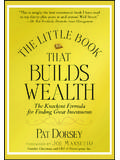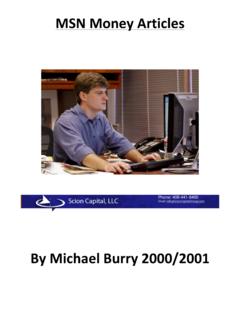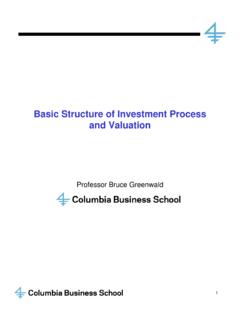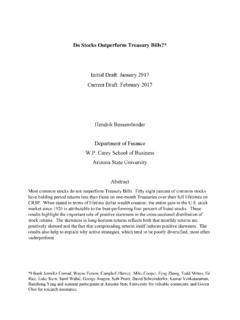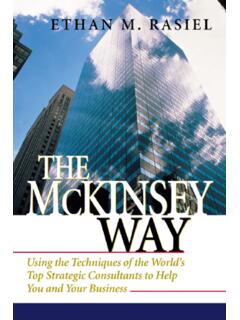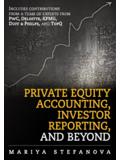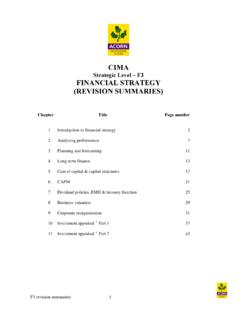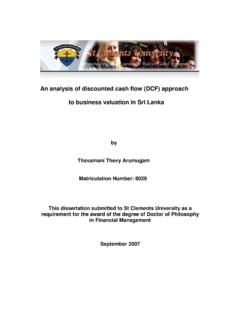Transcription of WHAT WORKS ON WALL STREET - Intensive investing …
1 what WORKS ON. WALL STREET . OTHER BOOKS BY JAMES P. O'SHAUGHNESSY. Invest Like the Best: Using Your Computer to Unlock the Secrets of the Top Money Managers How to Retire Rich: Time-Tested Strategies to Beat the Market and Retire in Style what WORKS ON. WALL STREET . A Guide to the Best- Performing Investment Strategies of All Time JAMES P. O'SHAUGHNESSY. Third Edition McGraw-Hill New York Chicago San Francisco Lisbon London Madrid Mexico City Milan New Delhi San Juan Seoul Singapore Sydney Toronto Copyright 2005 by James P. O'Shaughnessy. All rights reserved. Manufactured in the United States of America. Except as permitted under the United States Copyright Act of 1976, no part of this publication may be reproduced or distributed in any form or by any means, or stored in a database or retrieval system, without the prior written permission of the publisher.
2 0-07-146961-3. The material in this eBook also appears in the print version of this title: 0-07-145225-7. All trademarks are trademarks of their respective owners. Rather than put a trademark symbol after every occurrence of a trademarked name, we use names in an editorial fashion only, and to the benefit of the trademark owner, with no intention of infringement of the trademark. Where such designations appear in this book, they have been printed with initial caps. McGraw-Hill eBooks are available at special quantity discounts to use as premiums and sales promotions, or for use in corporate training programs. For more information, please contact George Hoare, Special Sales, at or (212).
3 904-4069. TERMS OF USE. This is a copyrighted work and The McGraw-Hill Companies, Inc. ( McGraw-Hill ) and its licensors reserve all rights in and to the work . Use of this work is subject to these terms. Except as permitted under the Copyright Act of 1976 and the right to store and retrieve one copy of the work , you may not decompile, disassemble, reverse engineer, reproduce, modify, create derivative WORKS based upon, transmit, distribute, disseminate, sell, publish or sublicense the work or any part of it without McGraw- Hill's prior consent. You may use the work for your own noncommercial and personal use; any other use of the work is strictly prohibited.
4 Your right to use the work may be terminated if you fail to comply with these terms. THE work IS PROVIDED AS IS. McGRAW-HILL AND ITS LICENSORS MAKE NO. GUARANTEES OR WARRANTIES AS TO THE ACCURACY, ADEQUACY OR COMPLETENESS. OF OR RESULTS TO BE OBTAINED FROM USING THE work , INCLUDING ANY. INFORMATION THAT CAN BE ACCESSED THROUGH THE work VIA HYPERLINK OR. OTHERWISE, AND EXPRESSLY DISCLAIM ANY WARRANTY, EXPRESS OR IMPLIED, INCLUDING BUT NOT LIMITED TO IMPLIED WARRANTIES OF MERCHANTABILITY OR. FITNESS FOR A PARTICULAR PURPOSE. McGraw-Hill and its licensors do not warrant or guarantee that the functions contained in the work will meet your requirements or that its operation will be uninterrupted or error free.
5 Neither McGraw-Hill nor its licensors shall be liable to you or anyone else for any inaccuracy, error or omission, regardless of cause, in the work or for any damages resulting therefrom. McGraw-Hill has no responsibility for the content of any information accessed through the work . Under no circumstances shall McGraw-Hill and/or its licensors be liable for any indirect, incidental, special, punitive, consequential or similar damages that result from the use of or inability to use the work , even if any of them has been advised of the possibility of such damages. This limitation of liability shall apply to any claim or cause whatsoever whether such claim or cause arises in contract, tort or otherwise.
6 DOI: To Lael, Kathryn, Patrick, and Melissa ABOUT THE AUTHOR. James P. O'Shaughnessy is the Director of Systematic Equity for Bear Stearns Asset Management and a Senior Managing Director of the firm. O'Shaughnessy's investment strategies have been featured in The Wall STREET Journal, Barron's, The New York Times, The Washington Post, Investor's Business Daily, The Financial Times, London's Daily Mail, Japan's Nikkei Shimbun Daily, and many other publications worldwide, as well as on NBC's Today Show, ABC's The Oprah Winfrey Show, CNBC, and CNN. Copyright 2005 by James P. O'Shaughnessy. Click here for terms of use. Wait for the wisest of all counselors, time.
7 Pericles This page intentionally left blank. For more information about this title, click here C O N T E N T S. Preface xviii Acknowledgments xx Chapter 1. Stock Investment Strategies: Different Methods, Similar Goals 1. Traditional Active Management Doesn't work 2. what 's the Problem? 3. Studying the Wrong Things 5. Why Indexing WORKS 5. Pinpointing Performance 7. Discipline Is the Key 7. Consistency Wins 8. A Structured Portfolio in Action 8. Overwhelmed by Our Nature 9. Case Study: The Dogs of the Dow 9. Chapter 2. The Unreliable Experts: Getting in the Way of Outstanding Performance 13. Human Judgment Is Limited 14.
8 what 's the Problem? 15. Why Models Beat Humans 15. Base Rates Are Boring 17. The Individual versus the Group 18. Personal Experience Preferred 19. Simple versus Complex 20. A Simple Solution 21. Additional Reading 23. Case Study: Using Long-Term Data to Make Predictions about the Future 24. ix x Contents Chapter 3. Rules of the Game 31. Short Periods Are Valueless 32. Anecdotal Evidence Is Not Enough 34. Potential Pitfalls 35. Rules of the Game 38. Chapter 4. Ranking Stocks by Market Capitalization: Size Matters 49. Best of Times, Worst of Times 51. How Much Better Are Small-Cap Stocks? 55. Reviewing Stocks by Size 57.
9 Small Stocks and Market Leaders 59. Small Stocks Are the Winners, But Not by Much 60. Market Leaders and Small Stocks: A Better Way to Create an Index 60. Implications for Investors 69. Our Two Benchmarks 70. Chapter 5. Price-to-Earnings Ratios: Separating the Winners and Losers 71. The Results 72. Large Stocks Are Different 76. High PE Ratios Are Dangerous 77. Large Stocks Fare No Better 83. Best- and Worst-Case Returns 84. Deciles 84. Implications 84. Following This Advice in Real Time 88. Chapter 6. Price-to-Book Ratios: A Better Gauge of Value 91. The Results 92. Large Stocks Are Less Volatile 93. Large Stocks Base Rates Are More Consistent 95.
10 Contents xi High Price-to-Book Stocks A Wild Ride to Nowhere 96. Large Stocks Are No Different 101. Best- and Worst-Case Returns 102. Deciles 103. Implications 104. Chapter 7. Price-to-Cashflow Ratios: Using Cash to Determine Value 109. The Results 110. Large Stocks Are Less Volatile 112. Worst-Case Scenarios and Best and Worst Returns 113. High Price-to-Cashflow Ratios Are Dangerous 116. Large Stocks Hit Too 120. Worst-Case Scenario and Best and Worst Returns 122. Deciles 123. Implications 126. Chapter 8. Price-to-Sales Ratios: The King of the Value Factors 127. The Results 128. Large Stocks with Low Price-to-Sales Ratios Do Well 131.
